Preparation and Characterization of Nylon 6/Silver Nanocomposite Fibers for Permanent Antibacterial Effect
Laleh Maleknia1*, A. Saeed Rashidi2
1Islamic Azad University, South Tehran Branch ,Department of Textile Engineering, Ahang Street,Nabard Blv,Tehran, Iran 2Islamic Azad University, Science and Research Branch, Department of Textile Engineering Poonak, Hesarak, Tehran, Iran
DOI : http://dx.doi.org/10.13005/ojc/310128
Article Received on :
Article Accepted on :
Article Published : 18 Feb 2015
The nylon 6/silver nano composite fibers were prepared for the attainment of permanent antibacterial activity to common synthetic textile. The fibers prepared by melt spinning and nylon 6/ Silver nanocomposite were prepared by a modular twin screw extruder.. The antibacterial activities of nano silver in fibers were calculated by percent reduction of two kinds of bacteria staphylococcus aurous and klebsiela peneumoniae. Scanning electron microscopy (SEM) was carried out to observe particle distribution on the nanocomposite fibers. All the nanocomposite fibers were characterized by instron machine.
KEYWORDS:Nylon 6; Antibacterial; Nano-Ag; Fiber
Download this article as:| Copy the following to cite this article: Maleknia L, Rashidi A. S. Studies on Chemical, Preparation and Characterization of Nylon 6/Silver Nanocomposite Fibers for Permanent Antibacterial Effect. Orient J Chem 2015;31(1). |
| Copy the following to cite this URL: Maleknia L, Rashidi A. S. Studies on Chemical, Preparation and Characterization of Nylon 6/Silver Nanocomposite Fibers for Permanent Antibacterial Effect. Orient J Chem 2015;31(1). Available from: http://www.orientjchem.org/?p=7274 |
Introduction
Textiles have long been recognized as media to support the growth of microorganisms such as bacteria and fungi. These microorganisms are found almost everywhere in the environment and can multiply quickly when basic requirements such as moisture, nutrients and temperature are met.1-2,Web-1 In recent years antibacterial agents that have been used industrially have included quarternary an ammonium salts, metal salt solution, and antibiotics. Unfortunately, some of these agents are toxic or poorly effective, which makes them not suitable for application in health foods, filters and textiles for the exclusion of pollution.3-6 Nanotechnology has real commercial potential for the textile industry. This is mainly due to the fact that conventional methods used to impart different properties to fabrics often do not lead to permanent effects, and will lose their functions after laundering or wearing. Nanotechnology also can provide high durability for fabrics, because nano-particles have a large surface area-to-volume ratio and high Surface energy, thus presenting better affinity for fabrics and leading to an increase in durability of the function. In addition, a coating of nano-particles on fabrics will not affect their breath ability or hand feel.7 For imparting anti-bacterial properties, nano-sized silver,8-12 titanium dioxide13-15 and zinc oxides are used. Metallic ions and metallic compounds display a certain degree of sterilizing effect.16
In contrast, silver, is a non-toxic non tolerant disinfectant that can reduce many bacterial infections significantly. As a natural renewable resource that has a number of unique properties silver now attracts an increasing amount of scientific and industrial interest from fields as diverse as chemistry, medicine, biotechnology, food science and textile science.3-6 Silver nanoparticles have the properties of a high surface area, very small size, and high dispersion. Several studies have been undertaken to explain the antibacterial properties of Ag ions toward bacteria. Polymeric or fibrous nano-composites of polymers and silver nanoparticle have been reported to have special properties.17-18
Nanocomposite fibers have attracted attention in recent years because improved mechanical, thermal, solvent resistance ad fire retardant properties compare to the pure or conventional composite fibers. Therefore, much work has focused on developing nanocomposite fibers using various polymers.19-20
he common technique to produce nanocomposite fibers is by melt compounding, which is the easiest and most cost effective method to produce nanocomposites materials.21
Nylon 6 is one of the most widely used synthetic fibers in textile industry. Besides, nylon 6 is well applicable for various fields, for example, carpet, sock, clothes, film and so on. Then the products made up of nylon 6 need antibacterial activity, one of the important functionalities, than the others.
In this study we prepared nylon/silver fiber using various concentration of Ag nano particles by melt spinning and compared their antibacterial efficacy.The structure and mechanical properties of nanocomposite fibers were analyzed by using Scanning electron microscopy(SEM) and Tensile testing measurement.and compared their antibacterial efficacy.
Experimental
Materials and Methods
The Ag nano powder were supplied by Lotus Ltd.Tehran (Iran) and nylon 6 chips were provided Alyaf Iran Co. Tehran, Iran.
All the materials were dried at 120ºC in vacuo for at least 12h to minimize the effect of moisture before being used. Nylon 6/Silver nanocomposite were prepared by a modular twin screw extruder. The temperatures of heating zones from hopper to die were set to 240, 255, 255, and 240ºC, respectively, and screw speed was fixed at 50 rpm. Melt spinning of the nanocomposite fibers was carried out using a single extruder with a capillary die of diameter 5 mm and an L/D ratio of 25. During the spinning process, the winding speed of the composite fiber was controlled at 2000 m/min with screw revolution speeds of 15 rpm respectively. The nanocomposite fiber composition and sample codes are shown in Table 1.
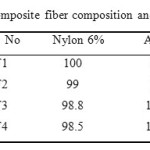 |
Table1: nanocomposite fiber composition and sample codes
|
The morphologies and sizes of the Ag nano particles were investigated by transmission electron microscopy (TEM). We used the AATCC-100 test method (antibacterial activity assessment of textile materials) to study the antibacterial properties of fabric finished with the nano-antibacterial agents. The fabrics were placed on a germ- containing agar plate and were inoculated with Gram- positive (staphylococcus aureus, ATCC 6538) and Gram negative (Klebsiella pneumoniaei ATCC 4352) bacteria. Specimens corresponding to untreated controls of the same material were placed in intimate contact with the nutrient agar, which previously had been streaked with inoculums of the test bacterium. After incubation for 24 h, we evaluated the antibacterial properties of both the untreated fabric and the treated fabrics.

A: The number of bacteria on the untreated fabric after 24h;
B: the number of bacteria on the antibacterial treated fabric after 24h.
The morphologies of the nanocomposite fibers samples were observed with a Scanning Electron Microscope (SEM) and elemental analysis was conducted with EDAX spectra. We used a sputter coater to precoat conductive gold onto the surface before measuring the micro structures.
Results and Discussion
Fig 1. Showed the TEM image of the Ag nanoparticles,the diameter of nanoparticles was estimated at 6nm-8 nm.
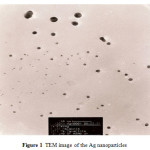 |
Figure1: TEM image of the Ag nanoparticles
|
Table 2 shows the antibacterial properties of nanocomposite fibers had excellent antibacterial effect on all specimens against S-aureus and Klebsiella pneumoniaei. It can be seen that the wool fabrics treated with colloidal nano silver had good antibacterial effect against S-aureus and Klebsiella pneumoniaei by 10 times washing .
Table 2: Antibacterial effect of nylon /silver nanocomposite fibers before and after washing: a. Nylon /silver nanocomposite fiber with 1% of Ag nano particle , b Nylon /silver nanocomposite fiber with 1.2% of Ag nano particle and c. Nylon /silver nanocomposite fiber with 1.5% of Ag nano particle
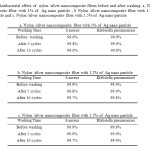 |
Table 2 Click here to View table |
The fiber surfaces of antibacterial treated fabrics were observed by SEM micro graphs. In fig 2, SEM images show the nanoparticles on PET/Cotton fabrics. The nanoparticles are well dispersed on these surfaces.
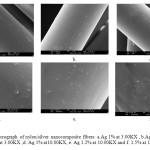 |
Figure2: SEM micrograph of nylon/silver nanocomposite fibers: a.Ag 1% at 3.00KX , b.Ag 1.2% at 3.00KX, c. 1.5% at 3.00KX ,d. Ag 1% at10.00KX, e. Ag 1.2% at 10.00KX and f. 1.5% at 10.00KX.
|
The characteristic peaks for different element in the functional layer are presented in EDAX spectra, which were obtained for the surface of samples shown in fig 3. It can be seen that the percent of nanoparticles on the surface of samples with increase percent of nanoparticles.
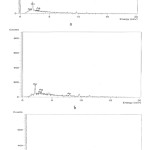 |
Figure3: EDAX spectra pattern of nylon nanocomposite fibers: Ag 1% ,b. Ag 1.2% and c. Ag 1.5 %
|
Mechanical properties of nylon fiber and nanocomposite fibers with1, 1.2 and 1.5% of silver nano particles was shown in table 3.
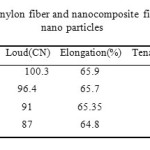 |
Table3: Mechanical properties of nylon fiber and nanocomposite fibers with1, 1.2 and 1.5% of silver nano particles
|
Conclusions
This study has shown the antibacterial efficiency was ever 99.5% after 10 washing time. SEM images shown the nanoparticles were well dispersed on samples. The results were obtained for the surface of samples shown that the percent of nanoparticles on the surface of samples with increase concentration of Ag nano particle.
References
- Gao, Y.; Cranston, R. Textile Res J. 2008 , 78, 60.
- Purwar, R.; Joshi, M. AATCC Review. 2004, 4, 22.
- Jeong, S.H.et al. Polymer Fibers. 2005 , 40, 5413.
- Morris, C.E.; Welch, C.E.; Textile Res J. 1983, 53, 725.
- Nakashima, T.et al. Ibid. 2001, 71,688.
- Joeger, T.et al. Tra Biotec. 2001, 19 ,15.
- Wong, Y. W. H.; Yuen, C. W. M.; Leung, M. Y. S.; Ku, S. K. A.; Lam, H. L. I. AUTEX Research Journal. 2006, 1,1-8
- Anonymous, Technical Textiles International, 2003, 3, 13-15.
- Yeo, S.Y.; Lee, H.J.; Jeong, S.H. Journal of Materials Science. 2003, 38, 2143-2147.
- Anonymous. Advance in Textiles Technology, 2003, 3, 10-11.
- Lee, H.J.; Yeo, S.Y.; Jeong, S.H. J. Mat. Sc. 2003, 38, 2199-2204.
- Yeo, S.Y.; Jeong, S.H. Pol. Int. 2003, 52, 1053-1057.
- Burniston, N.; Bygott, C.; Stratton. J. Surf. Coat. Int. A. 2004, 179-814.
- Sherman and Jonathan. Nanoparticulate Titanium Dioxide Coatings, and Processes for the Production and Use thereof, 2003, Pat. No 736738,
- Daoud, W.A.; Xin, J.H. J. Amer. Cer. Soc. 2004, , 87, 953-955.
- Saito, M. J. Coat. Fab. 1993, 23, 150-164.
- Yeo, S.Y.et al. J Mater Sci. 2003, 38, 2199.
- Yeo, S.Y.; Jeong, S.H. Poly. Int. 2003, 52, 1053.
- Kato, M.; Usuki, A.; Okada, A. J. Appl. Polym. Sci. 1997, 66,1781-1785.
- Kawasumi, M.; Hasegawa, N.; Kato, M.; Usuki, A.; Okada, A. Hybrids Macrmolecules. 1997, 30(20),6333-6338.
- Supri, A. G.; Salmah, H.; Hazvan, K. Malaysian Polymer Journal. 2008, 2, 39- 53.

This work is licensed under a Creative Commons Attribution 4.0 International License.









